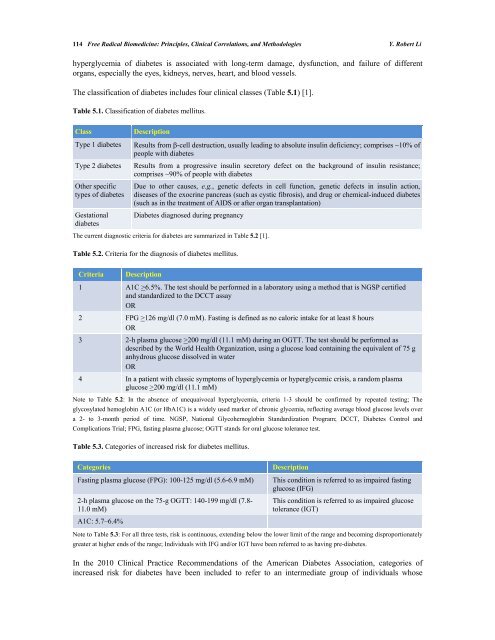Free Radical Biomedicine: Principles, Clinical ... - Bentham Science
Free Radical Biomedicine: Principles, Clinical ... - Bentham Science
Free Radical Biomedicine: Principles, Clinical ... - Bentham Science
You also want an ePaper? Increase the reach of your titles
YUMPU automatically turns print PDFs into web optimized ePapers that Google loves.
114 <strong>Free</strong> <strong>Radical</strong> <strong>Biomedicine</strong>: <strong>Principles</strong>, <strong>Clinical</strong> Correlations, and Methodologies Y. Robert Li<br />
hyperglycemia of diabetes is associated with long-term damage, dysfunction, and failure of different<br />
organs, especially the eyes, kidneys, nerves, heart, and blood vessels.<br />
The classification of diabetes includes four clinical classes (Table 5.1) [1].<br />
Table 5.1. Classification of diabetes mellitus.<br />
Class Description<br />
Type 1 diabetes Results from -cell destruction, usually leading to absolute insulin deficiency; comprises ~10% of<br />
people with diabetes<br />
Type 2 diabetes Results from a progressive insulin secretory defect on the background of insulin resistance;<br />
comprises ~90% of people with diabetes<br />
Other specific<br />
types of diabetes<br />
Gestational<br />
diabetes<br />
Due to other causes, e.g., genetic defects in cell function, genetic defects in insulin action,<br />
diseases of the exocrine pancreas (such as cystic fibrosis), and drug or chemical-induced diabetes<br />
(such as in the treatment of AIDS or after organ transplantation)<br />
Diabetes diagnosed during pregnancy<br />
The current diagnostic criteria for diabetes are summarized in Table 5.2 [1].<br />
Table 5.2. Criteria for the diagnosis of diabetes mellitus.<br />
Criteria Description<br />
1 A1C >6.5%. The test should be performed in a laboratory using a method that is NGSP certified<br />
and standardized to the DCCT assay<br />
OR<br />
2 FPG >126 mg/dl (7.0 mM). Fasting is defined as no caloric intake for at least 8 hours<br />
OR<br />
3 2-h plasma glucose >200 mg/dl (11.1 mM) during an OGTT. The test should be performed as<br />
described by the World Health Organization, using a glucose load containing the equivalent of 75 g<br />
anhydrous glucose dissolved in water<br />
OR<br />
4 In a patient with classic symptoms of hyperglycemia or hyperglycemic crisis, a random plasma<br />
glucose >200 mg/dl (11.1 mM)<br />
Note to Table 5.2: In the absence of unequaivocal hyperglycemia, criteria 1-3 should be confirmed by repeated testing; The<br />
glycosylated hemoglobin A1C (or HbA1C) is a widely used marker of chronic glycemia, reflecting average blood glucose levels over<br />
a 2- to 3-month period of time. NGSP, National Glycohemoglobin Standardization Program; DCCT, Diabetes Control and<br />
Complications Trial; FPG, fasting plasma glucose; OGTT stands for oral glucose tolerance test.<br />
Table 5.3. Categories of increased risk for diabetes mellitus.<br />
Categories Description<br />
Fasting plasma glucose (FPG): 100-125 mg/dl (5.6-6.9 mM) This condition is referred to as impaired fasting<br />
glucose (IFG)<br />
2-h plasma glucose on the 75-g OGTT: 140-199 mg/dl (7.8-<br />
11.0 mM)<br />
A1C: 5.7–6.4%<br />
This condition is referred to as impaired glucose<br />
tolerance (IGT)<br />
Note to Table 5.3: For all three tests, risk is continuous, extending below the lower limit of the range and becoming disproportionately<br />
greater at higher ends of the range; Individuals with IFG and/or IGT have been referred to as having pre-diabetes.<br />
In the 2010 <strong>Clinical</strong> Practice Recommendations of the American Diabetes Association, categories of<br />
increased risk for diabetes have been included to refer to an intermediate group of individuals whose

















